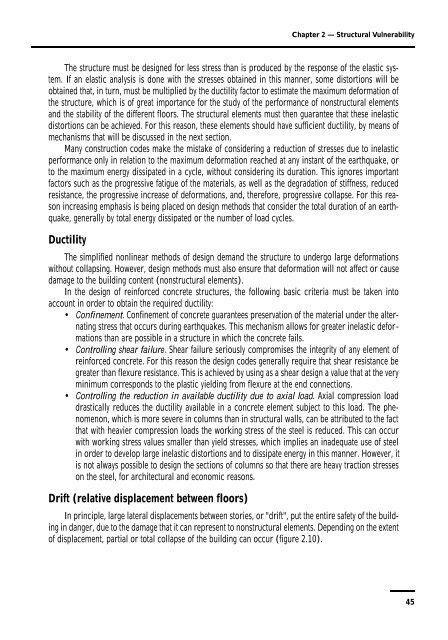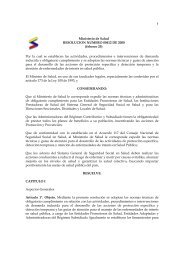Principles of Disaster Mitigation in Health Facilities - DISASTER info ...
Principles of Disaster Mitigation in Health Facilities - DISASTER info ...
Principles of Disaster Mitigation in Health Facilities - DISASTER info ...
You also want an ePaper? Increase the reach of your titles
YUMPU automatically turns print PDFs into web optimized ePapers that Google loves.
Chapter 2 — Structural Vulnerability<br />
The structure must be designed for less stress than is produced by the response <strong>of</strong> the elastic system.<br />
If an elastic analysis is done with the stresses obta<strong>in</strong>ed <strong>in</strong> this manner, some distortions will be<br />
obta<strong>in</strong>ed that, <strong>in</strong> turn, must be multiplied by the ductility factor to estimate the maximum deformation <strong>of</strong><br />
the structure, which is <strong>of</strong> great importance for the study <strong>of</strong> the performance <strong>of</strong> nonstructural elements<br />
and the stability <strong>of</strong> the different floors. The structural elements must then guarantee that these <strong>in</strong>elastic<br />
distortions can be achieved. For this reason, these elements should have sufficient ductility, by means <strong>of</strong><br />
mechanisms that will be discussed <strong>in</strong> the next section.<br />
Many construction codes make the mistake <strong>of</strong> consider<strong>in</strong>g a reduction <strong>of</strong> stresses due to <strong>in</strong>elastic<br />
performance only <strong>in</strong> relation to the maximum deformation reached at any <strong>in</strong>stant <strong>of</strong> the earthquake, or<br />
to the maximum energy dissipated <strong>in</strong> a cycle, without consider<strong>in</strong>g its duration. This ignores important<br />
factors such as the progressive fatigue <strong>of</strong> the materials, as well as the degradation <strong>of</strong> stiffness, reduced<br />
resistance, the progressive <strong>in</strong>crease <strong>of</strong> deformations, and, therefore, progressive collapse. For this reason<br />
<strong>in</strong>creas<strong>in</strong>g emphasis is be<strong>in</strong>g placed on design methods that consider the total duration <strong>of</strong> an earthquake,<br />
generally by total energy dissipated or the number <strong>of</strong> load cycles.<br />
Ductility<br />
The simplified nonl<strong>in</strong>ear methods <strong>of</strong> design demand the structure to undergo large deformations<br />
without collaps<strong>in</strong>g. However, design methods must also ensure that deformation will not affect or cause<br />
damage to the build<strong>in</strong>g content (nonstructural elements).<br />
In the design <strong>of</strong> re<strong>in</strong>forced concrete structures, the follow<strong>in</strong>g basic criteria must be taken <strong>in</strong>to<br />
account <strong>in</strong> order to obta<strong>in</strong> the required ductility:<br />
• Conf<strong>in</strong>ement. Conf<strong>in</strong>ement <strong>of</strong> concrete guarantees preservation <strong>of</strong> the material under the alternat<strong>in</strong>g<br />
stress that occurs dur<strong>in</strong>g earthquakes. This mechanism allows for greater <strong>in</strong>elastic deformations<br />
than are possible <strong>in</strong> a structure <strong>in</strong> which the concrete fails.<br />
• Controll<strong>in</strong>g shear failure. Shear failure seriously compromises the <strong>in</strong>tegrity <strong>of</strong> any element <strong>of</strong><br />
re<strong>in</strong>forced concrete. For this reason the design codes generally require that shear resistance be<br />
greater than flexure resistance. This is achieved by us<strong>in</strong>g as a shear design a value that at the very<br />
m<strong>in</strong>imum corresponds to the plastic yield<strong>in</strong>g from flexure at the end connections.<br />
• Controll<strong>in</strong>g the reduction <strong>in</strong> available ductility due to axial load. Axial compression load<br />
drastically reduces the ductility available <strong>in</strong> a concrete element subject to this load. The phenomenon,<br />
which is more severe <strong>in</strong> columns than <strong>in</strong> structural walls, can be attributed to the fact<br />
that with heavier compression loads the work<strong>in</strong>g stress <strong>of</strong> the steel is reduced. This can occur<br />
with work<strong>in</strong>g stress values smaller than yield stresses, which implies an <strong>in</strong>adequate use <strong>of</strong> steel<br />
<strong>in</strong> order to develop large <strong>in</strong>elastic distortions and to dissipate energy <strong>in</strong> this manner. However, it<br />
is not always possible to design the sections <strong>of</strong> columns so that there are heavy traction stresses<br />
on the steel, for architectural and economic reasons.<br />
Drift (relative displacement between floors)<br />
In pr<strong>in</strong>ciple, large lateral displacements between stories, or "drift", put the entire safety <strong>of</strong> the build<strong>in</strong>g<br />
<strong>in</strong> danger, due to the damage that it can represent to nonstructural elements. Depend<strong>in</strong>g on the extent<br />
<strong>of</strong> displacement, partial or total collapse <strong>of</strong> the build<strong>in</strong>g can occur (figure 2.10).<br />
45

















